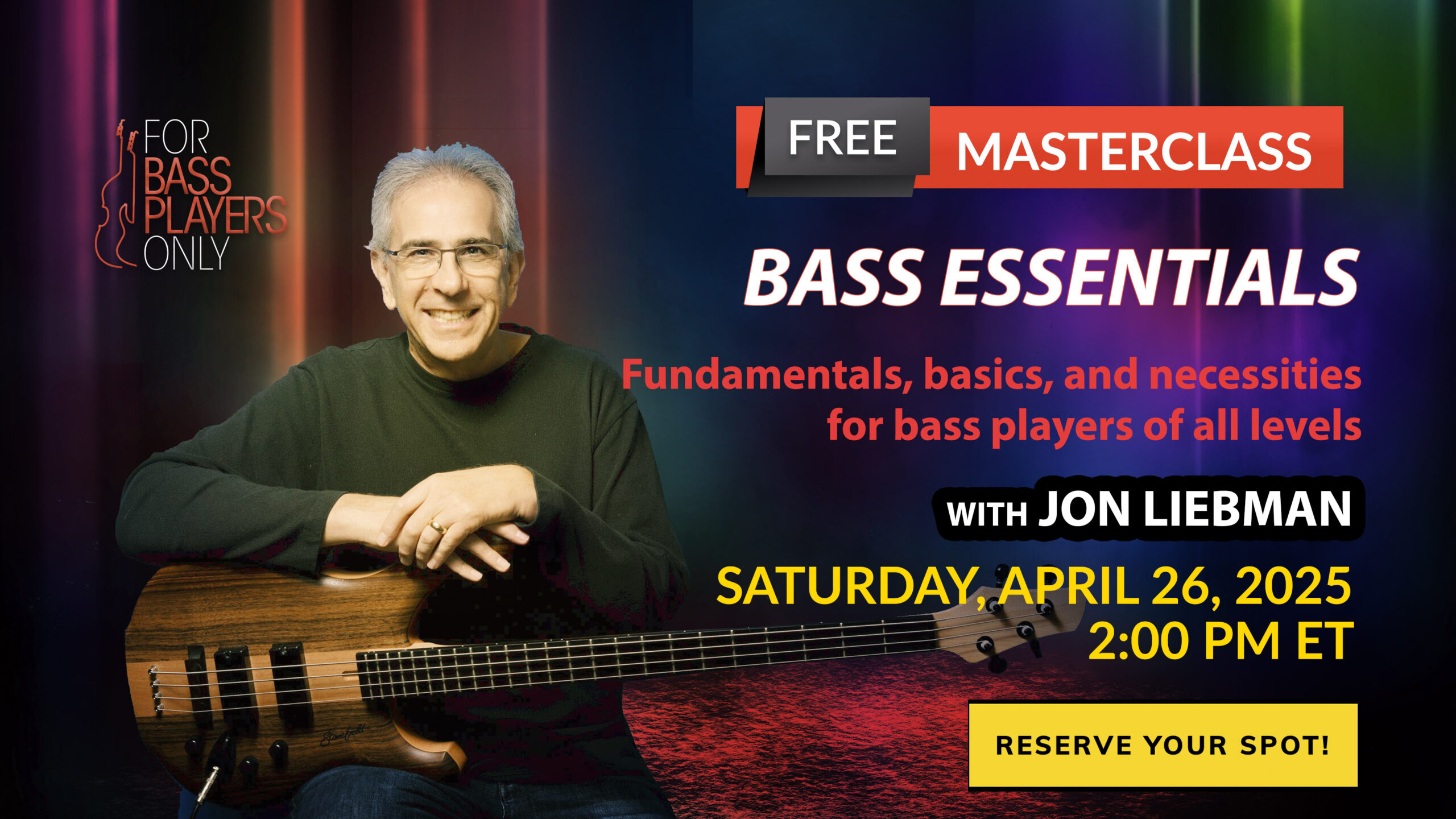Learning bass by associating hand positions with the sounds they make
By Jon Liebman
August 4, 2023
When you’re practicing the bass, how much does your mind separate the technical exercises from the musical stuff?
Maybe you have a bunch of “homework” to do, like scale studies, arpeggios, stuff like that. After that, when you get together with other people (or sit down with your backing tracks), what happens to your thought process?
It’s very common for the “practice stuff” to go completely out the window when you’re focused on making music.
But there’s a way to blend the two thought processes in a way that enhances both technical proficiency and the artistic music making.
Shaping the music by shaping your fingers
I had a great conversation recently with my longtime friend Stu Hamm, published as this week’s FBPO interview. Stu’s not only a great player, but a passionate bass educator too. So I asked him what advice he could impart to someone who wants to learn bass.
“Part of playing bass is mastering some coordination things to get your fingers to move correctly so you can make music,” he says. “And while you’re doing that, you can learn some basic shapes.”
In other words, while you’re going through the motions, you can get into a mindset that’s musical, and not purely technical.
“I’m big on hand positioning,” says Stu, “on outlining chords, because what does a bass do? It outlines the chord.”
As usual, start with the root. And then…
He went on to explain his process of starting with the root and building from there. “So you want to get fancy, you can play the root and the fifth, above or below,” he says. “Okay, now if it says minor 7th flat 5, maybe you’re going to play the minor 3rd.”
The more you know about music theory, the further you can take the process. “Okay, so let’s add the major and minor third,” Stu continues. “If you want to keep going and add the 7th, okay, then let’s throw in those arpeggios.”
The practice of practice
Stu’s approach is a great way to get different intervals and types of arpeggios under your fingers.
“It starts out as an exercise,” he says, “which is where I personally separate the practice of practice with the practice of playing.”
There it is. “The practice of practice.” Let’s take a step back and look at things in perspective. Practice is a means to an end. You practice the bass so you can make music.
Think about it. There’s a reason we want to master those scales, intervals, arpeggios… It’s so we can apply those skills to making music. Keep that in mind and you’ll make your practice time significantly more productive.
“As you learn these hand positions and chord positions,” Stu says, “your brain starts to associate the sound of those with the way your hand is.”
But there’s (always) a catch
Makes perfect sense to me. But it doesn’t just happen by itself.
“You gotta do the work,” says Stu. “I can show you some tricks to make it easier.” In the end, he says, “You have to make it interesting.”
Associating different hand shapes with actual sounds goes a long way in reminding us why we work on the technical stuff in the first place. For some people it comes more naturally than others, but the more you think about it while you’re practicing, the easier it will be to make that musical connection.
“I don’t know, man,” Stu says. “I think that unless you’re maybe Jeff Berlin or Victor Wooten or Biréli Lagrène, or Django Reinhardt, where you can just pick up any instrument and be amazing on it… some of us have to work at it.”
What about you?
When you’re practicing, how much thought do you give to the different ways you can apply your technical skills to making music? Leave a comment below and share your thoughts. Then check out my interview with Stu here.


I just read the key signature and play the notes. I can tune a tympani, but playing by ear I can’t do; I need the notes! I hate practicing.
Sorry to hear that, Joyce. Maybe you’d enjoy it more if you saw better results in your playing?
I think music theory is vital for playing bass. Once you are comfortable with it you become creative and musical. It also helps you play by ear once you know basic chord structures which are to go-to notes in most melodies, etc.
Spot on, Bruce. Thanks!
I’ll practice reading exercises then pick some good music to play with and try to incorporate what I’ve just practiced in the music. Try to find a home for the sounds I’ve just gotten under my hands.
Excellent. You’ve got the right idea, Steven. Thanks for weighing in.
Couple of comments. For Joyce – I started playing bass in 1970 refused to play solos until several years ago. What got me started was a fellow bassist here in Austin who suggested that I should first learn to play the melody. Sounds simple but many of us don’t do that. But it does make a difference – for me anyways.
One of my practice techniques is based on a Jerry Bergonzi suggestion. (Great sax player& teacher.) Pick a chord , lick , whatever. – currently I’m working on m7b5. Play it up and down the neck in standard inversion (1/b3/b5/b7/1). Do that as a warm up exercise for a week. Then switch it out -say 1/b5/b3/1/b7. After another week switch it up again. After a while you’ll own it. Also works with scales, riffs, whatever.
I love it! Thanks, Charlie.